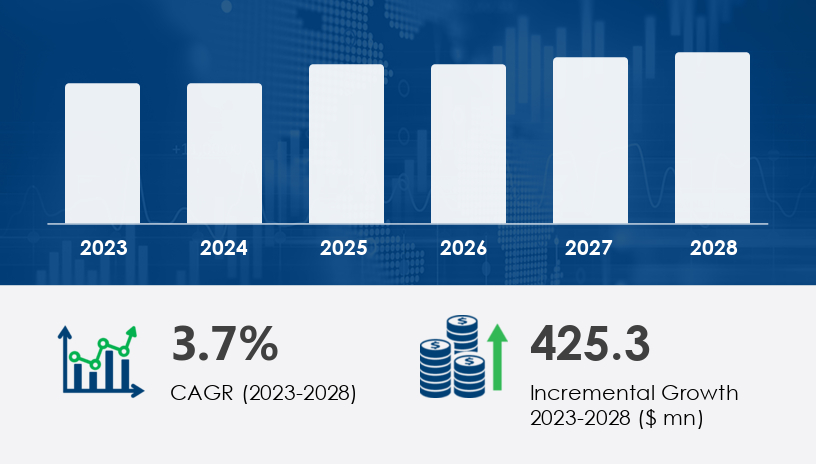Surgical Drainage Devices Market 2024-2028 Size and Trends
The surgical drainage devices market is expected to grow significantly, with a forecasted increase of USD 425.3 million, at a CAGR of 3.7% between 2023 and 2028. The demand for these devices is rising due to the increasing number of post-operative patients in hospitals, ambulatory surgical centers, and clinics. Key medical conditions, such as neurological diseases, eye diseases, and cardiovascular diseases, are driving the need for surgical interventions, thereby creating a higher demand for surgical drainage devices. The increasing popularity of minimally invasive surgeries has further fueled this demand, as these surgeries require effective drainage solutions to prevent complications and accelerate recovery.

For more details about the industry, get the PDF sample report for free
Market Segmentation
The market research report provides a comprehensive analysis of the following segments:
-
Application:
- Thoracic and cardiovascular surgeries
- Neurosurgical procedures
- Abdominal surgery
- Orthopedics
- Others
-
End-User:
- Hospitals
- Ambulatory surgical centers
- Clinics
-
Geography:
- North America: Canada, US
- Europe: Germany, UK, France, Italy
- Asia: China, India, Japan, South Korea
- Rest of World (ROW)
By Application Insights
The thoracic and cardiovascular surgeries segment is expected to experience substantial growth during the forecast period. There is an increasing demand for these devices due to the rising number of obesity-related cardiac surgeries, which carry a higher risk of postoperative complications, including bleeding and infection. The segment was valued at USD 800.30 million in 2018, and the rising number of reconstructive and cosmetic surgeries further contributes to the market’s expansion.
Market Dynamics
-
Drivers:
- The rise in the number of surgeries is a significant driver of market growth. In particular, the prevalence of chronic diseases, especially cancer, is leading to a higher demand for surgical drainage devices. As the number of surgeries increases, the need for post-operative care solutions, including drainage devices, also grows.
- The demand for minimally invasive surgeries is also driving market expansion. These procedures, which require effective fluid management, are becoming more common across medical specialties.
-
Trends:
- Local anesthesia delivery via surgical drains is a key trend in the market. This innovation allows for pain relief at the surgical site for extended periods after the procedure, reducing the reliance on systemic painkillers and improving patient outcomes.
- The increasing adoption of minimally invasive surgeries is contributing to the growth of the surgical drainage devices market. These surgeries benefit from drainage systems that minimize fluid accumulation and lower the risk of complications.
Get more details by ordering the complete report
-
Challenges:
- One of the key challenges faced by the market is the potential for postoperative complications associated with the use of surgical drainage devices. Risks such as infections, drain breakage, and complications during drain removal can prolong recovery and require additional interventions. Furthermore, issues like bacterial growth in the drainage system continue to be a concern, which could affect the effectiveness of the devices.
Key Players
Notable players in the surgical drainage devices market include:
- 3M Co. – Offers surgical drainage devices such as Prevena.
- ATMOS MedizinTechnik GmbH and Co. KG
- Axiom Medical Consulting LLC
- Becton Dickinson and Co.
- Bicakcilar Medical Devices
- Cardinal Health Inc.
- Chimed srl
- Cook Group Inc.
- Getinge AB
- Integra LifeSciences Holdings Corp.
- Johnson and Johnson Inc.
- Medela AG
- Medtronic Plc
- QMD
- Redax S.p.A.
- Sinapi Biomedical
- Smiths Group Plc
- Sterimed Medical Devices Pvt. Ltd.
- Stryker Corp.
- Teleflex Inc.
Future Market Insights
The surgical drainage devices market is set to experience robust growth driven by advancements in medical technology, increasing surgery rates, and the rising need for effective post-operative care. As surgical procedures become more sophisticated, there will be a greater demand for devices that can minimize complications and improve patient outcomes. With innovations in local anesthesia delivery and minimally invasive surgery, the market is poised for continued expansion throughout the forecast period.